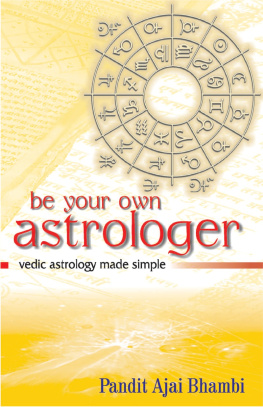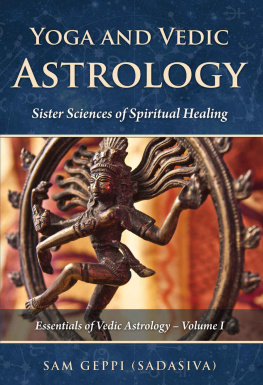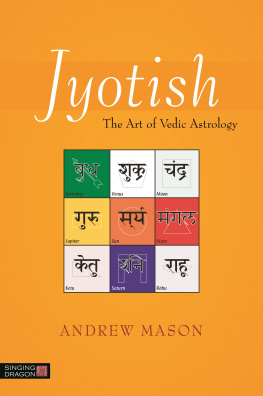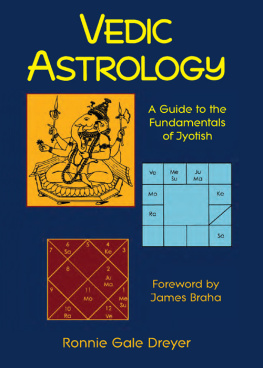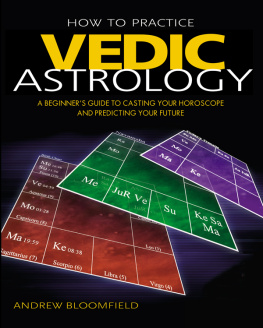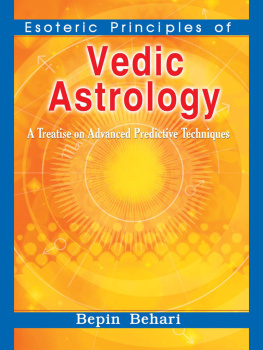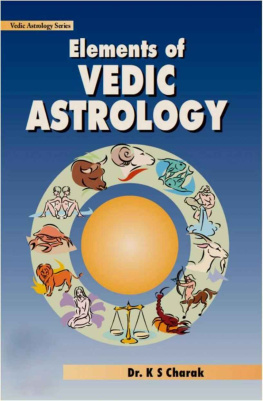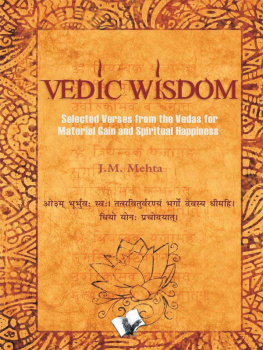

Ajai Bhambi, 2004
First published 2004
All rights reserved. No part of this publication may be reproduced or transmitted, in any form or by any means, without prior permission of the author and the publisher.
ISBN: 978-81-8328-417-2
Published by
Wisdom Tree,
4779/23, Ansari Road,
Darya Ganj, New Delhi-2
Ph.: 23247966/67/68
wisdomtreebooks@gmail.com
Printed in India
This book is dedicated to: This earth ( prithvi ) and sky ( akash ) have inspired and guided me whenever I stumbled. Ever since this realisation dawned upon me, I accepted them as my guru. I don't have any guru in physical form. This book of mine is dedicated to the earth and the sky.
CONTENTS
FOREWORD
I am grateful to Pandit Ajai Bhambi for asking me to pen a few words introducing his new book on astrology. I have known Pandit Bhambi for the last several years. He is an eminent astrologer and a very readable writer. He expresses himself very lucidly and appealingly in what he wishes to convey in his present publication Be Your Own Astrologer which is a significant contribution to the science of astrology.
At the very outset I wish to clarify that Ajai and I do not always approach any astrological problem from the same standpoint. He is extremely good in interactions with people which give him insight into human characteristics and what human beings want. This has helped him in expressing his astrological ideas in a very popular manner. His publication on annual predictions became well known for this very reason. In the present publication, Pandit Bhambi does not address his colleagues and learned astrologers who have already attained a certain level of predictive ability and have become impervious to new and unorthodox ideas. Be Your Own Astrologer addresses those who are almost new to the subject, open to new ideas, and drawn to it due to its popularity. Any book that raises serious and abstruse problems of higher predictive techniques would be unsuitable for such readers.
A beginner needs to know the historical background of the subject and its relationship with scripture, the karma theory and the scope of astrological predictions. Bhambi has introduced these subjects in a popular style for those who want to learn astrology but are averse to going into the deeper aspects of this subject. Astrology is said to be the oldest science on earth and is believed to have been revealed almost 15 million years ago when Lords of the Flame came to guide humanity in their evolutionary process. But they also gave rudiments of the subject, as it was suited to primitive human individuals. They revealed only seven signs of the subject and the seven planets. As and when human consciousness began to widen and human life became gradually more complicated, greater details of astrology were revealed. Pandit Bhambi in his wisdom thought that a beginning of the subject from the Vedic priests could attract the lay readers.
Astrology is primarily based on house divisions, zodiacal signs and planets. The author has done well to introduce these subjects at the very beginning. He has also incorporated a chapter on symbols and allegorical stories in relation to signs and planets. The study of occult symbols and their application to astrology need a deep study. It is as well that he does not delve deep into the subject before giving his own interpretation of astrological symbols. Personally I would have liked him to introduce the methodology for intersection of symbols as well as their allegorical meaning and interpretation, so that the readers could venture to interpret astrological signs and planets in their own way.
Astrological predictions could be very elaborate but beginners have to be told the central point, so that they themselves are able to make predictions. Ajai has kept this in view when he gives details of a planets results in different houses, different signs and so on. This is a good section which the readers may find helpful.
Ajai Bhambi has provided horoscopes of certain eminent persons, who probably consulted him. A novice needs to know how to interpret a chart and Ajai Bhambi has done so without spoiling the popular nature of the publication.
I like the author and his present publication for an important reason. A Tibetan master of wisdom recently wrote that astrology, as now studied and taught, misleads more than it helps and students of astrology are as yet learning but the a, b, c of this stupendous subject, and are occupied with the esoteric fringes of that great veil which has been wisely thrown over all planetary lures. Probably, and rightly so, Pandit Ajai Bhambi has attempted to pulverise the traditional system of astrology, so that students as well as practitioners may adjust to the need of a new form of astrology and begin to seriously consider the task of reconstructing the new age astrology.
September 2003 | Bepin Behari C-505, Yojna Vihar, Delhi-110092 |
PREFACE
The idea of writing this book was conceived almost a decade ago. There were lots of questions troubling my mind as to how to encapsulate so wide a subject as astrology in one book. As astrology is as vast as an ocean, the task was enormous and very difficult to accommodate into one book. Another question was whether to write it in a book form or make audio cassettes. Suggestions came from well-wishers that it should be in both forms book as well as audio. Finally, I decided to let this book be in audio form. I packed my bags and baggage and travelled to many places in India as well as abroad to record my voice. Many cassettes were recorded but later I decided to drop the idea and give it a book form.
A question has the tendency to become bigger and bigger unless it finds a suitable answer, but the answers which come from outside are not answers in the real sense. In fact, a question is an answer in itself. Before one arrives at the answer, a question will keep on becoming bigger and bigger till the questioning stops within.
The universal symbol of question (?) is the same. Sometimes a question becomes so big that it seems as though the entire sky is covered by this question mark. If the upper hook of the question is straightened, then this question mark becomes a straight line (I) and no longer seeks an outside answer.
When I developed interest in astrology more than three decades ago, I laid hands on some books written by eminent astrologers, but could not understand much. The books were so exhaustively written with all technicalities included that it almost scared me to go through the pages of those books. I had to struggle for a long time to realise the meaning of certain technical terms and understand their impact on the human being. Subsequently, I decided that, to make the reader understand the subject well, I should try to write a book and make it so simple that the layman, just as I was then, gets enlightened after reading the book. I feel a book can be considered readable if it provokes or pacifies the thoughts of the reader. This book shall be able to do either of these two things, or maybe both, too.
I strongly believe that the origin of astrology began with the cave man. He was the first to notice and observe the cosmos. Astonished, baffled, confused yet satisfied with whatever little knowledge he had about the different phenomena around him, the cave mans child-like innocence and curiosity to question and seek answer to every new phenomenon helped him develop his intelligence over passage of time.

